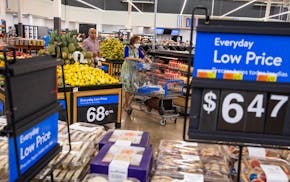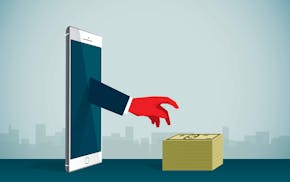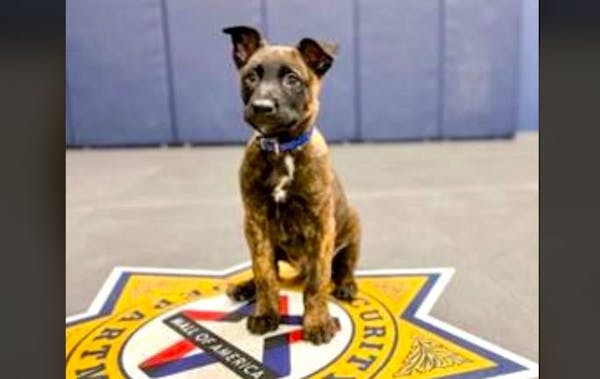An eight-week-old puppy tripped over his paws as he sniffed for treats in the Mall of America's basement in late March.
When he's older — and if his training goes well — the canine will eventually use his snout to detect firearms as one of the mall's first gun-sniffing dogs, part of a new security plan to make the country's shopping destination safer.
Retailers have long debated how to keep stores secure but still welcoming. That has become even more complicated for shopping centers such as the Mall of America as well as retailers such as Target, Best Buy and smaller Twin Cities area stores whose private safety protocols are now under greater public scrutiny.
Nationwide, retailers reported more than a 26% increase in organized retail crimes in 2021, according to a report the National Retail Federation (NRF) released this past fall. Eight in 10 said the violence and aggression associated with those incidents has increased.
This past holiday season, for example, the Mall of America experienced the first fatal shooting in its 30-year history. In November, Target said it lost $400 million worth of inventory, mostly from crime, and expected that number to grow to more than $600 million for the full year. That aligns with one argument that lawbreakers have become more shameless and violent with smash-and-grab shoplifting.
Yet another view blames viral social media videos — of crimes and interactions with security officers — for ramping up awareness. Walgreens CFO James Kehoe said in January that his company might have "cried too much last year" about theft and over-secured its stores.
"We're having this really tough debate," said Jason Matlock, co-founder of a Twin Cities consultancy helping organizations plan for critical incidents. "OK, we want safety, but how do we get there?"
Striking a balance
The Mall of America has several layers of security, most of which have existed for years: bike officers, license plate readers, an intelligence analyst, a Bloomington police satellite station with uniformed police officers, a camera system, an underground emergency operations center, teams of mall security with plain-clothes officers, even a team of six explosives-detecting dogs.
Despite its protocols, the mall has recently struggled with safety. When 19-year-old Johntae Hudson was fatally shot inside the Nordstrom store on Dec. 23, it marked the third time in a year the mall went into lockdown.
"It's no secret we [had] a lot of challenges last year," said Will Bernhjelm, Mall of America vice president of security, who gave rare security tours of the mall last month.
Last fall, the mall tried using artificial intelligence scanners to detect weapons. However, with around 30 entrances and thousands of visitors a day, it wasn't "a good fit," Bernhjelm said.
The mall still practices random, unannounced bag checks at its doors. Mall of America officials have also tested a shot-detection program — which detects the sound of gunshots and alerts security to the location — and are considering facial recognition software, used with the mall's cameras to help identify trespassing individuals.
The Mall of America's reputation as a safe place, whether from violence or simply the elements, means most weekday mornings before stores even open, early-bird regulars are already there.
Bloomington neighbors Dianne Erickson and Deanna O'Brien, both 85, often see friends as they grab their coffees and head to their usual meeting place at the tables in front of Nordstrom. They have been walking at the mall for at least 20 years and are there most every day.
While the women have hadn't any problems, the new measures, such as bag checks, help increase their comfort. O'Brien said they "always see security" while Erickson said it makes her feel safer.
However, not all patrons have the same view of the mall's security presence.
Jackie Barabash, 53, of Minneapolis, who is at the Mall of America four to five times a week because her daughter works there, said she thinks the mall's security can be excessive at times.
"It's very uncomfortable to see police officers walking around the mall ... holding rifles with their hands on the trigger or observing security or police surrounding a person," she said.
Simon Osamoh, founder of Minneapolis security risk management firm Kingswood Security Consulting, said retailers are in a "new world where part of their marketing campaign has to show the public they are safe."
"They are being forced to be more transparent with their customers," he said. "Where you shop in today's world is a choice, and safety has now become part of that choice."
'Math that retailers have to do'
In recent weeks, violence and crime at Twin Cities retail locations have made headlines. Jadonn Taylor, 23, died after someone shot him in the East Side St. Paul Target parking lot. Police recently found bullet casings and damaged windows at the Southdale Center mall.
"We have seen, over the last few years, a complete change in the shoplifting environment where you have groups that are walking into locations openly and brazenly stealing mass quantities of merchandise. ... We've also seen the violence increase," said David Johnston, the NRF's vice president for asset protection and retail operations who used to lead loss prevention for brands like Dunkin' Donuts and Buffalo Wild Wings.
Offenders seem to take higher risks, committing more open crime with seemingly little fear of repercussion, Osamoh said. The former head of counterterrorism for the Mall of America said criminals upload their crimes on social media, whether to brag of their accomplishment or market stolen goods for resale. He added that sometimes videos show perpetrators goading store employees or security guards.
Smash-and-dash thefts have affected retailers across the country, including locally headquartered Target and Best Buy.
In March, police arrested thieves who allegedly used sledgehammers to shatter displays and steal electronics at the North St. Paul Target. Back in 2021, Best Buy also experienced thefts with as many as 20 to 30 assailants, though there haven't been as many high-profile cases since.
At certain locations, both Target and Best Buy have hired security and locked up certain easy-to-steal products, like toothpaste and headphones. To try to limit how this may affect customer experience, Best Buy has started to let customers scan the QR code for some locked, high-value products and pick up their order at checkout or bring a card for the item to an employee, who retrieves it.
At its flagship downtown Minneapolis store, Target began to lock up some products like toiletries last fall. Target also temporarily locked the doors and atrium on the street level as it remodeled, added more security and reduced its hours because of "a rise in disruptive activity," according to a Target spokesperson. Not long before that, the retailer shuttered its attached liquor store, partly due to public safety concerns. Other retailers have similarly cut their losses and just closed stores with safety problems.
"That's the math that retailers have to do," said Matlock of Alleyne, Matlock & Associates.
At his Games by James mall stores, owner Logan McKee said he trains his staff to take a softer approach to security. Many measures in his stores revolve around acknowledging customers.
"If we see them steal something, we just take it as a customer service opportunity like, 'Hey, do you have questions about those cards?'" McKee said.
While McKee has seen more "gutsy" thieves — like someone who ran into his St. Cloud store and swiped a $120 board game — he said opportunistic teens commit most of the crime in his stores, and keeping popular items close to the register mostly deters them.
"It really just comes down to being attentive," he said.
Minnesota's med spa industry rises in popularity — and with little regulation

Ramstad: Readers say Walmart won't be paying the ultimate price of Trump's tariffs

How Minnesota businesses can spot and prevent invoice fraud
No place for cryptocurrency in retirement portfolios

